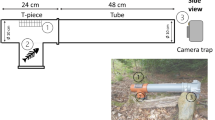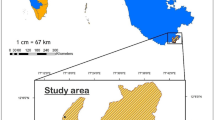Abstract
Cat predation of birds in residential landscapes is ephemeral, unpredictable, and spatially dispersed, and thus requires many person-hours to observe. We sought to identify whether specific behaviors, traits, or feeding ecologies of birds contribute to their probability of cat-caused mortality around residences across temperate North America. In addressing this question, we evaluated citizen science data with respect to peer-reviewed species accounts (Birds of North America, BNA). Using information on cat predation from the BNA, we found that species that glean their prey from the ground or breed in nest boxes were three times more likely to be depredated by cats, while birds that hawk were over two times less likely to become cat prey than would be predicted by random chance. Data from citizen science sources also showed that birds using nest boxes had increased susceptibility to cat predation, as did those that use feeders and that glean from foliage. We caution that observations of predation by citizen science volunteers may be biased towards detection at feeders. Future research should focus on developing volunteer survey techniques for improving estimates of bird mortality rates and sources.

Similar content being viewed by others
References
Akaike H (1973) Information theory and an extension of the maximum likelihood principle. In: Petrov BN, Csaki F (eds) Second international symposium on information theory. Akademiai Kiado, Budapest, pp 267–281
American Bird Conservancy (1997) Human attitudes and behaviors regarding cats. In: Cats Indoors: the campaign for safer birds and cats. Washington, DC
American Bird Conservancy (2007) Domesticated cat predation on birds and other wildlife. Available from http://www.abcbirds.org/cats. Accessed 26 April 2012
Baker PJ, Bentleys AJ, Ansell RJ, Harris S (2005) Impact on predation by domestic cats Felis catus in an urban area. Mammal Review 35:302–312
Balogh AP, Ryder TB, Marra PP (2011) Population demography of Gray Catbirds in the suburban matrix: sources, sinks and domestic cats. Journal of Ornithology
Barratt DG (1997) Predation by house cats, Felis catus (L.), in Canberra, Australia. I. Prey composition and preference. Wildlife Research 24:263–277
Beckerman AP, Boots M, Gaston KJ (2007) Urban bird declines and the fear of cats. Animal Conservation 10:320–325
Bonney R, Dhondt AA (1997) FeederWatch: an example of a Student-Scientist Partnership. Chapter 3. In: KC Cohen (ed) Internet links for science education: Student-Science Partnerships. Plenum Press, New York
Bonney R, Cooper CB, Dickinson J, Kelling S, Phillips T, Rosenberg K, Shirk J (2009) Citizen Science: a new paradigm for increasing science knowledge and scientific literacy. BioScience 59:977–984
Brieman L, Spector P (1992) Submodel selection and evaluation in regression. The X-random case. International Statistical Review 60:291–319
Brossard D, Lewenstein B, Bonney R (2005) Scientific knowledge and attitude change: the impact of a citizen science project. International Journal of Science Education 27:1099–1121
Buckland ST, Anderson DR, Burnham KP, Laake JL (1993) Distance sampling: estimating abundance of biological populations. Chapman and Hall, London, p 446
Burnham KP, Anderson DR (2002) Model selection and inference: an information-theoretic approach. Springer, New York
Calver MC, Grayson J, Lilith M, Dickman CR (2011) Applying the precautionary principle to the issue of impacts by pet cats on urban wildlife. Biological Conservation 144:1895–1901
Coleman JS, Temple SA, Craven SR (1997) Cats and wildlife: a conservation dilemma. University of Wisconsin Cooperative Extension Publications
Coman BJ, Brunner H (1972) Food habits of the feral house cat in Victoria. J Wildl Manag 36:848–853
Cooper CB, Dickinson J, Phillips T, Bonney R (2007) Citizen science as a tool for conservation in residential ecosystems. Ecol Soc 12(2):11. http://www.ecologyandsociety.org/vol12/iss2/art11/. Accessed 26 April 2012
Cooper CB, Hochachka WM, Dhondt AA (2012) The opportunities and challenges of Citizen Science as a tool for ecological research. In: Dickinson JL, Bonney R (eds) Citizen science: public collaboration in environmental research. Cornell University Press, Ithaca, NY
Cresswell W, Lind J, Kaby U, Quinn JL, Jakobsson S (2003) Does an opportunistic predator preferentially attack nonvigilant prey? Anim Behav 66:643–648
Crooks KR, Soule ME (1999) Mesopredator release and avifaunal extinctions in a fragmented system. Nature 400:563–566
Dauphine N, Cooper RJ (2009) Impacts of free-ranging domestic cats (Felis catus) on birds in the United States: a review of recent research with conservation and management recommendations. Proceedings of the 4th international partners in flight conference: tundra to tropics, 205–219
Dickinson JL, Zuckerberg B, Bonter DN (2010) Citizen science as an ecological research tool: challenges and benefits. Annual Review of Ecology, Evolution and Systematics 41:149–172
Dunn EH, Tessaglia DL (1994) Predation of birds at freeders in winter. Journal of Ornithology 65:8–16
Dunning JB (1984) Body weights of 686 species of North American birds. West. Bird Banding Assoc. Monogr. No. I. Eldon Publishing, CaveCreek, AZ
Efron B (1983) Estimating the error rate of a prediction rule: improvement on cross-validation. Journal of the American Statistical Association 78:316–331
Ehrlich PR, Dobkin DS, Where D (1988) The birder’s handbook. Simon & Schuster Inc, New York
Evans C, Abrams E, Reitsma R, Roux K, Salmonsen L, Marra P (2005) The Neighborhood Nestwatch program: participant outcomes of a Citizen-Science ecological research project. Conservation Biology 19:589–594
Fitzgerald BM (1990) Is cat control needed to protect urban wildlife? Environmental Conservation 17:168–169
Fitzgerald BM, Turner DC (2000) Hunting behavior of domestic cats and their impact on prey populations. In: Turner DC, Bateson P (eds) The domestic cat: the biology of its behavior. Cambridge University Press, Cambridge, UK, pp 152–175
Fukunaga K, Kessell D (1971) Estimation of classification error. IEEE Transaction on Computers C-20:1521–1527
Galloway AWE, Tudor MT, Haegen WMV (2006) The reliability of citizen science: a case study of Oregon White Oak Stand Surveys. Wildlife Society Bulletin 34:1425–1429
Gering JC, Blair RB (1999) Predation on artificial bird nests along an urban gradient: predatory risk or relaxation in urban environments? Ecography 22:532–541
Hawkins CC, Grant WE, Longnecker MT (2004) Effect of house cats, being fed in parks, on California birds and rodents. In: Shaw et al (eds) Proceedings 4th international urban wildlife symposium, pp 164–170
Hosmer DH, Lemeshow S (1989) Applied logistic regression. Wiley, New York
Jansson C, Ekman J, von Bromssen A (1981) Winter mortality and food supply in tits Parus spp. Oikos 37:313–322
Jarvis PJ (1990) Urban cats as pests and pets. Environmental Conservation 17:169–171
Jokima¨ ki J, Huhta E (2000) Artificial nest predation and abundance of birds along an urban gradient. Condor 102:838–847
King WB (1985) Island birds: will the future repeat the past? In: Moors PJ (ed) Conservation of Island Birds. International Council of Bird Preservation, Cambridge, pp 3–15
Kress S (2006) The Audubon society guide to attracting birds: creating natural habitats for properties large and small. Cornell University Press, NY
Lepczyk CA, Mertig AG, Liu J (2004) Assessing landowner activities related to birds across rural-to-urban landscapes. Environmental Management 33:110–125
Lerman SB, Warren PS (2011) The conservation value of residential yards: linking birds and people. Ecological Applications 21:1327–1339
Liberg O, Sandell M, Pontier D, Natoli E (2000) Density, spatial organization and reproductive tactics in the domestic cat and other felids. In: Turner DC, Bateson P (eds) The domestic cat: the biology of its behavior. Cambridge University Press, Cambridge, UK, pp 120–147
Osborn RG, Higgins KF, Usgaard RE, Dieter CD, Neiger RD (2000) Bird mortality associated with wind turbines as the Buffalo Ridge Wind Resource Area, Minnesota. Am Midl Nat 143:41–52
Pearre S, Maass R (1998) Trends in the prey size-based trophic niches of feral and House Cats Felis catus L. Mamm Rev 28:125–139
Peck DR, Faulquier L, Pinet P, Jaquemet S, Le Corre M (2008) Feral cat diet and impact on sooty terns at Juan de Nova Island, Mozambique Channel. Animal Conservation 11:65–74
Poole A (ed) (2005) The birds of North America. http://bna.birds.cornell.edu/BNA/. Cornell Laboratory of Ornithology, Ithaca, NY
Popp JW (1988) Scanning behavior of finches in mixed-species groups. Condor 90:510–512
R (2009) The R project for statistical computing. The R Foundation. University of Auckland, New Zealand
Rodewald AD, Kearns LJ, Shustack DP (2011) Antropogenic resource subsidies decouple predator-prey relationships. Ecol Appl 21:936–943
Rosenzweig M (2003) Win-win ecology, how the earth’s species can survive in the midst of human enterprise. Oxford University Press, Oxford, UK
Ryder TB, Reitsma R, Evans B, Marra PP (2010) Quantifying avian nest survival along an urbanization gradient using citizen- and scientist-generated data. Ecological Applications 20:419–426
Shochat E (2004) Credit or debit? Resource input changes population dynamics of city-slicker birds. Oikos 106:622–626
Shochat E, Lerman SB, Anderies JM, Warren PS, Faeth SH, Nilon CH (2010) Invasion, competition, and biodiversity loss in urban ecosystems. BioScience 60:199–208
Silvertown J (2009) A new dawn for Citizen Science. Trends Ecol Evol 24:467–471
Stracey C (2011) Resolving the urban nest predator paradox: the role of alternative foods for nest predators. Biological Conservation 144:1545–1552
Tallamy D (2009) Bringing nature home: how you can sustain wildlife with native plants. Timber Press, Portland, OR
Thompson S, Bonney R (2007) Evaluating the impacts of participation in an online citizen science project: a mixed-methods approach. In: Trant J, Bearman D (eds) Museums and the web. Archives and Museum Informatics, Toronto, pp 187–199
Thorington KK, Bowman R (2003) Predation rates on artificial nests increase with human housing density in suburban habitats. Ecography 26:188–196
Trumbull DJ, Bonney R, Bascom D, Cabral A (2000) Thinking scientifically during participation in a citizen-science project. Science Education 84:265–275
Van Heezik Y, Smyth A, Adams A, Gordon J (2010) Do domestic cats impose an unsustainable harvest on urban bird populations? Biological Conservation 143:121–130
Waite TA (1987) Vigilance in the White-breasted Nuthatch: effects of dominance and sociality. Auk 104:429–434
Woods M, McDonald RA, Harris S (2003) Predation of wildlife by domestic cats Felis catus in Great Britain. Mammal Review 33:174–188
Zanette LY, White AF, Allen MC, Clinchy M (2011) Perceived predation risk reduces the number of offspring songbirds produce per year. Science 334:1398–1401
Acknowledgments
We are thankful to all those who took part in My Yard Counts and PredatorWatch. We appreciate input from Chris Wood on the natural history Table. Staff in Bird Population Studies and Citizen Science at the Cornell Lab of Ornithology gave valuable input throughout the course of this research. Tessa Murante reported these findings as part of her Honors Thesis at Cornell University.
Author information
Authors and Affiliations
Corresponding author
Appendix
Appendix
See Table 4
Rights and permissions
About this article
Cite this article
Cooper, C.B., Loyd, K.A.T., Murante, T. et al. Natural History Traits Associated with Detecting Mortality Within Residential Bird Communities: Can Citizen Science Provide Insights?. Environmental Management 50, 11–20 (2012). https://doi.org/10.1007/s00267-012-9866-x
Received:
Accepted:
Published:
Issue Date:
DOI: https://doi.org/10.1007/s00267-012-9866-x




